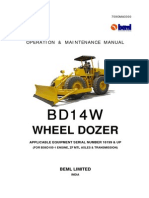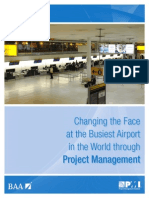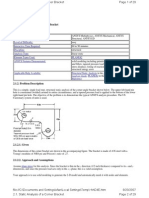Letourneau - 1 Introduction
Uploaded by
ALONSO SOLÍSLetourneau - 1 Introduction
Uploaded by
ALONSO SOLÍSGO TO SERVICE MANUAL TABLE OF CONTENTS GO TO SECTION 1 TABLE OF CONTENTS
INTRODUCTION
SECTION 01-01
LeTourneau has made every effort to make this manual as accurate as possible based on the information
available at the time of publication and printing. Continuous improvement and advancement of product design
may cause changes to machines, which may not have been included in this publication. LeTourneau reserves
the right to make changes and improvements at any time. To ensure the most current information, please
contact your dealer representative.
TABLE OF CONTENTS
SAFETY .............................................................................................................................................................. 3
GENERAL DESCRIPTION OF MACHINE ......................................................................................................... 4
LETOURNEAU FRONT-END LOADER OR DOZER (L/D) OPERATING ENVIRONMENT ............................. 5
SERVICE MANUAL AND PARTS CATALOG ................................................................................................... 5
THANK YOU FOR CHOOSING LETOURNEAU ............................................................................................... 6
SAFETY AND OPERATIONAL ADVISORY ...................................................................................................... 6
SECTION 01-01.DOC r00er1 COPYRIGHT 2013
L-1150/1350/1850/2350 01-01-1
1/21/2013 LeTourneau
GENERATION2 INTRODUCTION
THIS PAGE INTENTIONALLY LEFT BLANK
COPYRIGHT 2013 SECTION 01-01.DOC r00er1
01-01-2 L-1150/1350/1850/2350
LeTourneau 1/21/2013
INTRODUCTION GENERATION2
CUSTOMER RESPONSIBILITIES AND WARRANTY ADVISORIES
LeTourneau loaders/dozers are warranted in accordance with the warranty policy provided with the machine.
The recommended operating and maintenance procedures set forth shall be followed to ensure warranty
coverage is not jeopardized. Failure to comply with recommended operating and maintenance procedures
may void machine warranty.
Any questions or problems relating to warranty policy or administration should be directed to LeTourneau,
P.O. Box 2307, Longview, Texas 75601, Attention: Warranty Manager. Include the model and serial number,
in-service date of the machine, and hour meter reading. We especially draw your attention to the
following advisories:
SAFETY
This publication contains special instructions that pertain to safety, operation, maintenance, and repair of the
machine. Listed below are the signal words and symbols that precede these instructions and their meanings:
The danger label indicates a hazardous situation which, if not avoided, will result in death or
serious injury.
The warning label indicates a hazardous situation which, if not avoided, could result in death or
serious injury.
The caution label, used with the safety alert symbol indicates a hazardous situation which, if not
avoided, could result in minor or moderate injury (includes the safety alert symbol ).
The caution label (without safety alert symbol) is used to address practices not related to
personal injury – only equipment damage.
The NOTE graphic is to indicate areas of importance to the reader that are not related to personal
injury or machine damage.
SECTION 01-01.DOC r00er1 COPYRIGHT 2013
L-1150/1350/1850/2350 01-01-3
1/21/2013 LeTourneau
GENERATION2 INTRODUCTION
GENERAL DESCRIPTION OF MACHINE
LeTourneau machines are rugged articulated front-end loaders/dozers specifically built for long lasting
operation in many environments. The machine’s bucket or blade (as applicable) size is determined by the
weight (density) of the material to be handled.
A diesel engine and an SR generator provide power to electric traction motors that propel the machine at
variable speeds, forward and reverse. This power train is augmented by additional fluid power systems that
control all bucket/blade, hoist/tilt/pitch and steering operations (as applicable).
The four drive motors are coupled to planetary gearboxes sometimes referred to as “drivers”. Operation of the
machine is further enhanced by a solid-state drive system.
Braking is accomplished by three separate systems. The primary braking system utilizes characteristics of the
drive motors, causing “dynamic braking”. The secondary system, the service brake, is an air-operated disc
brake attached to each motor shaft. The third system, the parking brake, is a spring-applied, air release
brake.
GENERAL INFORMATION provides illustrations of the major features and dimensions and a
specifications list for the machine. Loader illustrations are used in the manual when providing
information that is applicable to both Loaders and Dozers.
TYPICAL LOADER TYPICAL DOZER
COPYRIGHT 2013 SECTION 01-01.DOC r00er1
01-01-4 L-1150/1350/1850/2350
LeTourneau 1/21/2013
INTRODUCTION GENERATION2
LETOURNEAU FRONT-END LOADER OR DOZER (L/D) OPERATING
ENVIRONMENT
LeTourneau rubber-tired front-end machines are designed as rugged all-weather tools for various industries.
They are designed as off-highway equipment for use in various applications that are in remote locations. Due
to their very large size, they must work in an area with few other machines, and the only proximity to buildings
would be for routine maintenance or repair. They are not to be operated near office buildings or residential
areas.
The operators of this machine are advised not to approach local residences or business
establishments within a distance of 328 yards (300 meters) in order to prevent interference with their
television and radio reception.
LOADERS: The primary function of the loader is to load or move loose material (i.e. blasted rock,
crushed stone, sand, coal, overburden etc.) into hauling units such as mining trucks and rail trains. A
typical application would be loading end-dump mining trucks from a bank of blasted rock.
A loader should never be used as a dozer. The dozer is specifically designed to push materials,
whereas the loader is designed to lift and move loose material.
DOZERS: The primary function of the dozer is to move loose material (i.e. blasted rock, crushed stone,
sand, coal, overburden, wood chips etc.). A typical application would be moving overburden and dumps.
The machines can withstand and are fully functional in temperatures ranging from -40° F to +122° F (-40° C
to +50° C), 0-100% humidity, and in all forms of precipitation, day or night. Operating elevation is limited by
the restrictions placed on the diesel engine power unit. The machine operating elevation can exceed 14,260
ft. (4500 meters).
SERVICE MANUAL AND PARTS CATALOG
The SERVICE MANUAL provides instructions for operating, safety and preventive maintenance,
troubleshooting, and repair. Each publication has its own table of contents that lists the individual topics under
the major subheadings.
The OPERATOR’S HANDBOOK provides a limited version of machine specifications and basic safety and
operating instructions as a supplement to the Service Manual.
The PARTS CATALOG contains part numbers, illustrations, and schematics to aid in ordering parts from
LeTourneau to service and repair the machine.
Verify numbers of parts, tools, or material by using the PARTS CATALOG, or contact your authorized
LeTourneau dealer for assistance. Do not order parts from the SERVICE MANUAL (with the exception of
some tools and special items).
Items described as "Optional" may not be available on all models.
LeTourneau cannot anticipate every possible circumstance that might involve a potential hazard. The
warnings in this publication and on the product are therefore not all inclusive. These rules will not
apply to all situations. If a tool, procedure, work method, or operating technique is used, the owner
must be satisfied that it is safe for all personnel. Also, ensure that the product will not be damaged or
made unsafe by the operation, lubrication, maintenance, or repair procedures chosen. Operating the
machine on different job sites and under various environments can create safety hazards unique to
that particular situation. If a dangerous situation develops under these circumstances, only the
alertness of the operator and proficiency in operating the machine are available to cope with the
situation.
SECTION 01-01.DOC r00er1 COPYRIGHT 2013
L-1150/1350/1850/2350 01-01-5
1/21/2013 LeTourneau
GENERATION2 INTRODUCTION
THANK YOU FOR CHOOSING LETOURNEAU
We believe you will be delighted with the machine's performance, and feel sure that the payback on your
investment will be a rapid one. Should you need to discuss some aspects of the design as it relates to the
capability of your machine, your dealer will be glad to assist you. If additional information is needed, the
dealer will contact the factory. In the unlikely event you are unable to obtain the information in this manner,
contact the LeTourneau Product Support Group in Longview, Texas by telephone at 903-236-6584 or by FAX
at 903-236-6548. Be sure to have available the model, serial number, hour meter reading, and in-service date
of the machine.
SAFETY AND OPERATIONAL ADVISORY
The instructions provided in this publication are for operating the machine under normal conditions. As each
workplace and operating situation is different, LeTourneau cannot anticipate unusual or extreme
circumstances that might require additional safety precautions or modifications in machine operation in
addition to those covered in this publication. Therefore, it is essential to become familiar with extreme or
unusual situations that are unique to the workplace that might warrant a modification of the instructions
contained herein. Contact an authorized LeTourneau dealer or the LeTourneau Product Support Group in
Longview, Texas, for assistance should any operating or maintenance practice needed to accommodate the
working environment, require a departure from the instructions contained in this publication.
COPYRIGHT 2013 SECTION 01-01.DOC r00er1
01-01-6 L-1150/1350/1850/2350
LeTourneau 1/21/2013
You might also like
- LIEBHERR T282 Maintenance Manual 293-296No ratings yetLIEBHERR T282 Maintenance Manual 293-29624 pages
- 795F Ac Off-Highway Truck: Global Manpower DevelopmentNo ratings yet795F Ac Off-Highway Truck: Global Manpower Development11 pages
- ERS - Raptor Wear Product & Dipper Door Solutions PDFNo ratings yetERS - Raptor Wear Product & Dipper Door Solutions PDF12 pages
- Safety Data Sheet: Nickel-Cadmium Aircraft Cells and BatteriesNo ratings yetSafety Data Sheet: Nickel-Cadmium Aircraft Cells and Batteries7 pages
- Manual de Operacioncargador Frontal P&H l2350No ratings yetManual de Operacioncargador Frontal P&H l2350202 pages
- 160,000 Lbs (72,574 KGS) 53 Yd (40.52 M) Standard Operating CapacityNo ratings yet160,000 Lbs (72,574 KGS) 53 Yd (40.52 M) Standard Operating Capacity6 pages
- Generation 2: Wheel Loader Product Overview50% (2)Generation 2: Wheel Loader Product Overview7 pages
- 7495 Con Hydracrowd Pala Eléctrica de Cable CaterpillarNo ratings yet7495 Con Hydracrowd Pala Eléctrica de Cable Caterpillar3 pages
- Unit Rig Mt4400 Ac Off-Highway Truck: Global Manpower DevelopmentNo ratings yetUnit Rig Mt4400 Ac Off-Highway Truck: Global Manpower Development19 pages
- Hydraulic Shovel: Engine Bucket Operating Specifications100% (1)Hydraulic Shovel: Engine Bucket Operating Specifications32 pages
- 854K Wheel Dozer Launch: Bud Wettstone Marketing SupervisorNo ratings yet854K Wheel Dozer Launch: Bud Wettstone Marketing Supervisor19 pages
- 994H Wheel Loader: Global Manpower DevelopmentNo ratings yet994H Wheel Loader: Global Manpower Development12 pages
- Mining Truck: Engine Weights - Approximate Operating SpecificationsNo ratings yetMining Truck: Engine Weights - Approximate Operating Specifications28 pages
- EH4500 2 - EH5000+Hoist+System - HTT4500 (2) 13 0508100% (2)EH4500 2 - EH5000+Hoist+System - HTT4500 (2) 13 050883 pages
- M0080743 - Ball Stud Breaker (524-9370 Hammer Group) PDF100% (1)M0080743 - Ball Stud Breaker (524-9370 Hammer Group) PDF47 pages
- Unit Rig Mt3700 Ac Off-Highway Truck: Global Service Training100% (1)Unit Rig Mt3700 Ac Off-Highway Truck: Global Service Training18 pages
- Better Braking Bigger Payload Superior ServiceabilityNo ratings yetBetter Braking Bigger Payload Superior Serviceability1 page
- Ayuda para Reparacion Comp - Electronico Estado Solido100% (2)Ayuda para Reparacion Comp - Electronico Estado Solido118 pages
- Tennant 7200 Rider Floor Scrubber Service ManualNo ratings yetTennant 7200 Rider Floor Scrubber Service Manual270 pages
- Operator’S Guide to Rotating Equipment: An Introduction to Rotating Equipment Construction, Operating Principles, Troubleshooting, and Best PracticesFrom EverandOperator’S Guide to Rotating Equipment: An Introduction to Rotating Equipment Construction, Operating Principles, Troubleshooting, and Best Practices5/5 (4)
- Chainsaw Operator's Manual: Chainsaw Safety, Maintenance and Cross-cutting TechniquesFrom EverandChainsaw Operator's Manual: Chainsaw Safety, Maintenance and Cross-cutting Techniques5/5 (1)
- FOR EMAIL 53EBDE Ok v3 TOE SEries 2018 - REVISED 3rd Quarter 2019No ratings yetFOR EMAIL 53EBDE Ok v3 TOE SEries 2018 - REVISED 3rd Quarter 2019172 pages
- Invitation: The Southern Region Mes Employees' UnionNo ratings yetInvitation: The Southern Region Mes Employees' Union4 pages
- Advanced Novell Network Management Netware 6No ratings yetAdvanced Novell Network Management Netware 6699 pages
- Global Truck 9 troubleshooting throttle issue.No ratings yetGlobal Truck 9 troubleshooting throttle issue.11 pages
- EA-2 17 2009 - EA Guidance On The Horizontal Requirements For The Accreditation of Conformity Assessment Bodies For Notification Purposes100% (1)EA-2 17 2009 - EA Guidance On The Horizontal Requirements For The Accreditation of Conformity Assessment Bodies For Notification Purposes40 pages
- Nationalizing The Global Media Images, Cultural Politics and The Middle Class in IndiaNo ratings yetNationalizing The Global Media Images, Cultural Politics and The Middle Class in India19 pages
- The CPL Exams: CHUF - CPL Human Factors ExaminationNo ratings yetThe CPL Exams: CHUF - CPL Human Factors Examination5 pages
- (ROM) (TW) (BQK6) (7.1.1) (J500x) Odyssey Note8 V - Samsung Galaxy J5No ratings yet(ROM) (TW) (BQK6) (7.1.1) (J500x) Odyssey Note8 V - Samsung Galaxy J525 pages
- 2.1. Static Analysis of A Corner Bracket 2.1.1. Problem SpecificationNo ratings yet2.1. Static Analysis of A Corner Bracket 2.1.1. Problem Specification29 pages
- 795F Ac Off-Highway Truck: Global Manpower Development795F Ac Off-Highway Truck: Global Manpower Development
- ERS - Raptor Wear Product & Dipper Door Solutions PDFERS - Raptor Wear Product & Dipper Door Solutions PDF
- Safety Data Sheet: Nickel-Cadmium Aircraft Cells and BatteriesSafety Data Sheet: Nickel-Cadmium Aircraft Cells and Batteries
- 160,000 Lbs (72,574 KGS) 53 Yd (40.52 M) Standard Operating Capacity160,000 Lbs (72,574 KGS) 53 Yd (40.52 M) Standard Operating Capacity
- 7495 Con Hydracrowd Pala Eléctrica de Cable Caterpillar7495 Con Hydracrowd Pala Eléctrica de Cable Caterpillar
- Unit Rig Mt4400 Ac Off-Highway Truck: Global Manpower DevelopmentUnit Rig Mt4400 Ac Off-Highway Truck: Global Manpower Development
- Hydraulic Shovel: Engine Bucket Operating SpecificationsHydraulic Shovel: Engine Bucket Operating Specifications
- 854K Wheel Dozer Launch: Bud Wettstone Marketing Supervisor854K Wheel Dozer Launch: Bud Wettstone Marketing Supervisor
- Mining Truck: Engine Weights - Approximate Operating SpecificationsMining Truck: Engine Weights - Approximate Operating Specifications
- EH4500 2 - EH5000+Hoist+System - HTT4500 (2) 13 0508EH4500 2 - EH5000+Hoist+System - HTT4500 (2) 13 0508
- M0080743 - Ball Stud Breaker (524-9370 Hammer Group) PDFM0080743 - Ball Stud Breaker (524-9370 Hammer Group) PDF
- Unit Rig Mt3700 Ac Off-Highway Truck: Global Service TrainingUnit Rig Mt3700 Ac Off-Highway Truck: Global Service Training
- Better Braking Bigger Payload Superior ServiceabilityBetter Braking Bigger Payload Superior Serviceability
- Ayuda para Reparacion Comp - Electronico Estado SolidoAyuda para Reparacion Comp - Electronico Estado Solido
- Operator’S Guide to Rotating Equipment: An Introduction to Rotating Equipment Construction, Operating Principles, Troubleshooting, and Best PracticesFrom EverandOperator’S Guide to Rotating Equipment: An Introduction to Rotating Equipment Construction, Operating Principles, Troubleshooting, and Best Practices
- Chainsaw Operator's Manual: Chainsaw Safety, Maintenance and Cross-cutting TechniquesFrom EverandChainsaw Operator's Manual: Chainsaw Safety, Maintenance and Cross-cutting Techniques
- FOR EMAIL 53EBDE Ok v3 TOE SEries 2018 - REVISED 3rd Quarter 2019FOR EMAIL 53EBDE Ok v3 TOE SEries 2018 - REVISED 3rd Quarter 2019
- Invitation: The Southern Region Mes Employees' UnionInvitation: The Southern Region Mes Employees' Union
- EA-2 17 2009 - EA Guidance On The Horizontal Requirements For The Accreditation of Conformity Assessment Bodies For Notification PurposesEA-2 17 2009 - EA Guidance On The Horizontal Requirements For The Accreditation of Conformity Assessment Bodies For Notification Purposes
- Nationalizing The Global Media Images, Cultural Politics and The Middle Class in IndiaNationalizing The Global Media Images, Cultural Politics and The Middle Class in India
- The CPL Exams: CHUF - CPL Human Factors ExaminationThe CPL Exams: CHUF - CPL Human Factors Examination
- (ROM) (TW) (BQK6) (7.1.1) (J500x) Odyssey Note8 V - Samsung Galaxy J5(ROM) (TW) (BQK6) (7.1.1) (J500x) Odyssey Note8 V - Samsung Galaxy J5
- 2.1. Static Analysis of A Corner Bracket 2.1.1. Problem Specification2.1. Static Analysis of A Corner Bracket 2.1.1. Problem Specification

























































































